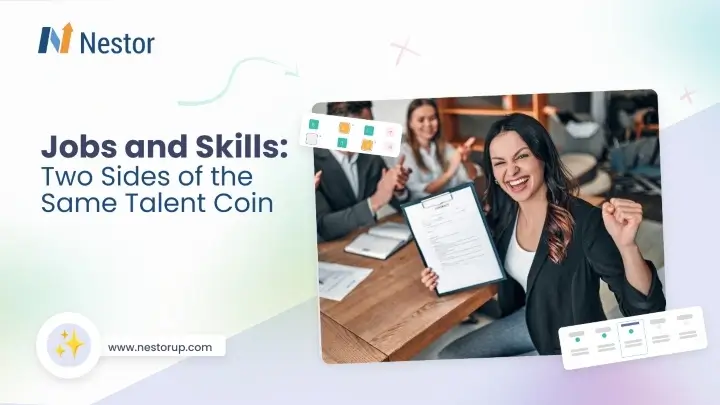
In the current business landscape, organizations are facing increasing difficulties in finding and keeping talent. Various factors are behind this situation, from the lack of alignment between educational curricula and real-life work skills to technological advancements and the evolving needs and expectations of newer workforce members, especially Gen Zers. This is where skills-based strategies come in!
Embracing skills-based practices has emerged as a powerful solution to help employers hire, develop and prepare their employees for the future of work by focusing on the skills that actually matter for the business strategy, all while ensuring an effective workforce planning. Even though skills-based strategies are usually related to hiring processes, the truth is that they can be applied across multiple areas, like compelling employee development through dynamic career paths, strategic planning; they also impact performance, productivity as well as engagement.
Understanding employee skills and skill gaps and mapping them with job roles, performance expectations and business goals can also pinpoint strategic decisions that can translate into cost optimizations. They can shed light on where to redeploy your people to fulfill your business needs, what are the best-fit development opportunities inside the organization considering employee’s actual skills and whether to consider internal development through upskilling versus external recruitment.
However, many organizations have only a vague understanding of their existing skills and capabilities and thus a limited capacity to pivot quickly to market disruptions.
2 in 5 HR leaders acknowledge they don’t know what skills they have in their workforce.
— Mercer
To bridge that gap in understanding, in this article, we’ll focus on what makes skills-based strategies so important in the modern world of work. We’ll also go over the most common roadblocks to adopting these strategies and how you can overcome them. Let’s dive right in!
Why are skills-based talent strategies important to HR?
Skills-based talent strategies are a powerful solution, which, if implemented well, can align every step of the employee journey (hiring, onboarding, training, retention) with the present and long-term organizational needs. And the direct benefits cannot be overlooked:
- Increased organizational agility: Businesses that prioritize skills are more resilient, adaptable, and innovative. They respond to new developments faster and are able to bring together cross-departmental teams that tackle projects with great speed and efficiency.
- Strategic workforce planning: Skills-based talent strategies simplify and improve the allocation of resources, which increases collaboration between employees with complementary skill sets and reduces over-reliance on specific individuals.
- Optimized L&D: Skills-based practices will enable learning & development specialists to identify and select opportunities that are better suited for the organizational needs and in alignment with people’s career aspirations.
- Clear career pathways: Centering talent strategies around skills will simplify the process of creating transparent ways to advance within the organization (both vertically and laterally). Each role will have a well-defined set of skills and proficiency levels that will make it easy for both employees and managers to plan progression and succession.
- Expanded talent pools: By focusing on skills instead of degree requirements, years of experience, and other credentials, organizations will open the doors to wider pools of untapped candidates, who would normally be looked over or filtered out during the initial pre-screening stage.
- Skills development interrelated to performance management: Skills-based practices can help align employee development with performance evaluations, ensuring the focus is on gaining or expanding skills and monitoring the progress of your overall workforce capability. By incorporating personalized learning objectives into performance management, organizations can further accelerate employees’ development and enhance their active involvement in the learning journey.
Participants in our survey cited sourcing, validating skills, and scaling skills-based practices across the organization as three of the most common challenges they faced when implementing a skills-based approach.
— McKinsey
Which are the main challenges of implementing skills-based talent strategies?
While skills-based talent strategies can take an organization to the next level, the most difficult part is connected to identifying and collecting the skills that are critical to achieve the desired business outcomes and support innovation.
1. Resistance to change
Embracing skills-based practices represents a shift in paradigm, in how things are done and also a shift in how work is defined and talent decisions are made.
And while traditional job roles and expectations aren’t going away, the architecture for work is rapidly shifting from jobs to skills. This shift often involves new ways of working, including project-based approaches, temporary teams based on agile workforces, and other similar initiatives.
Solution: To fully benefit from the flexibility and resilience of skills-based talent models, organizations need to move fast and adopt future-focused models early on.
These new practices can be implemented gradually, starting with only one team or department at first. The initial results and insights can then be used to iterate further and define agile ways to help speed up the adoption across other departments.
2. Lack of skill visibility at the organizational level
Skills-based talent strategies rely on identifying capabilities, proficiency levels, and gaps across the entire organization and making them transparent.
When transparency and centralization are not present, both employees and their managers will struggle to adapt or even understand the expectations under the new approach.
Solution: A skills taxonomy can help you identify the essential — current and future — skills for business success. Developing one starts with:
- deciding which type of skills you want to collect: soft, hard, digital skills
- enforcing a transparent framework: clear proficiency levels
- involving people in the process: be open to suggestions
- make use of the right tools and platforms to collect skills insights from 360 feedback, performance reviews or skills assessments etc.
To start, you can focus on identifying a number of soft skills (15-30) that all workers should have and additional specialized skills (5-10), which are a must-have for each role or department. The goal is to create a flexible model, that can evolve in time and serve as a stable foundation.
Nestor’s platform not only brings this type of tools together but also creates dynamic employee skill profiles, displaying in real time the capabilities of your workforce and potential areas for improvement — making the lack of skills visibility a thing of the past.
3. High level of complexity in collecting skills
Depending on the size of your organization, gathering data on skills and proficiency levels can quickly become a challenging task — especially when the process involves aligning multiple team leads and department heads.
Solution: The best way to approach this entire process is to break it down into small steps and focus on one or two departments and the most critical roles. Perhaps, you can start with only one set of skills, let’s say soft skills instead of hard skills. Through constant evaluation and iteration, you will eventually identify the best methods of collecting skills for your specific needs, which can then be applied to all the other departments.
4. Inability to identify and map the required skills for each role
It’s easy to understand why companies don’t start shifting to skills-based practices despite realizing their importance. It’s not always clear where or how to start. It requires a plan and some effort — and among the constant pressure to deliver results and meek KPIs, it can get lost in the ‘nice to have’ pile of ideas.
Solution: Organizations that are serious about this shift need a well-defined strategy with the clear goal of establishing:
- skills needed for each role
- potential skills required in the future
- skills already present
- gaps to be covered through strategic hiring or upskilling and reskilling
This strategy should also highlight the transferable skills — both existent and desirable — that can help employees advance faster or move to entirely different roles.
5. Lack of specialized tools for tracking evolving skill needs
Missing specialized tools can also limit your ability to proactively identify skills for the future or gaps that can emerge further down the line.
Solution: Skill management software is a powerful solution that outlines the strengths, weaknesses, and potential areas of development of your employees. This type of software facilitates regular skills gap analyses and, when integrated with other HR platforms, helps managers track the progress of their team members.
Still, one of the problems related to skills management software is that most employees don’t complete or update their skills profile.
By continuously embedding skills into processes like performance reviews, development plans, surveys, 360 feedback, skills assessments, or growth opportunities, a skills management software like Nestor ensures the automatic extraction of skills data and compile them into a unified skills-based profile, dynamically enriched over time with new capabilities acquired in the process.
6. Seeing skills-based talent strategies as the sole responsibility of HR
While talent strategies fall into the category of HR responsibilities, the success of transitioning to a skills-based approach will depend on many other stakeholders.
This includes department heads, managers, team leads, and perhaps above all support from the C-suite or business leadership. Without having them fully on board with this paradigm shift, things will not move forward.
Solution: HR strategists can first explore by themselves methods to implement skills-based practices and the specific advantages for their organization. Once the benefits and drawbacks are identified, the next step is to share the insights with the leadership and get their support.
As a start, it’s enough to get the approval of trying it out with a single team or department. But the truth is that going forward, the shift will require changes at every level of the organization — and that aspect should be clear from the beginning.
Organizations that cannot connect skills to work are at risk of being outpaced by those that can more rapidly deploy mission-critical talent.
— Mercer
Final thoughts

While shifting to skills-based strategies isn’t necessarily easy or fast, the long-term impact of doing so could be fundamental for remaining competitive and relevant in the changing business landscape.
In fact, the following insights from Deloitte sum up everything you need to know. According to them, skills-based organizations are:
- 107% more likely to place talent effectively
- 98% more likely to have a reputation as a great place to grow and develop
- 98% more likely to retain high performers
- 79% more likely to have a positive workforce experience
- 57% more likely to anticipate change and respond effectively and efficiently
- 52% more likely to innovate
- 49% more likely to improve processes to maximize efficiency
- 47% more likely to provide an inclusive environment
Are you ready to make the change? Nestor’s People Intelligence Platform is here to be your partner and help unlock the full power of your talented workforce. To learn more about our offerings, schedule a demo.








